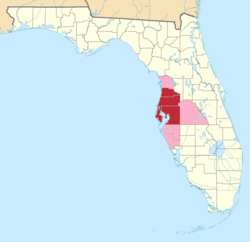
Back Área de la Badea de Tampa AST تامپا بای ئیرا AZB Tampa Bay Area German Área de la Bahía de Tampa Spanish ناحیه خلیج تامپا Persian Aire urbaine de la baie de Tampa French אזור מפרץ טמפה HE タンパベイ・エリア Japanese 탬파베이 지역 Korean Área da baía de Tampa Portuguese
Tampa Bay Area
Tampa–St. Petersburg–Clearwater MSA | |
|---|---|
 | |
 The Tampa–St. Petersburg–Clearwater Metropolitan Statistical Area (red) and other counties which are sometimes considered to be part of the Tampa Bay Area (pink). | |
| Country | United States |
| State | Florida |
| Largest city | Tampa |
| Other major cities | |
| Population (2020) | 3,175,275 |
• Estimate (2022) | 3,290,730 |
| Ranked 17th in the US | |
| GDP | |
| • MSA | $219.4 billion (2022) |
| Time zone | UTC−05:00 (EST) |
| • Summer (DST) | UTC−04:00 (EDT) |
| Area code(s) | 813, 656, 727, 352, 863 941 |
The Tampa Bay area is a major metropolitan area surrounding Tampa Bay on the Gulf Coast of Florida in the United States. It includes the main cities of Tampa, St. Petersburg, and Clearwater. It is the 17th-largest metropolitan area in the United States, with a population of 3,175,275 as of the 2020 U.S. Census.
The exact boundaries of the metro area can differ in different contexts. Hillsborough County and Pinellas County (including the cities of Tampa, St. Petersburg, Clearwater, and various smaller communities) make up the most limited definition. This area includes most of the Tampa Bay bayfront, aside from the far southern portion which lies in Manatee County. The U.S. Office of Management and Budget (OMB) defines the Tampa–St. Petersburg–Clearwater Metropolitan Statistical Area (MSA) as including Hillsborough and Pinellas Counties as well as Hernando and Pasco Counties to the north; and it is the 18th-most populous MSA in the country.[2][3] The MSA was first defined in 1950 as the Tampa-St. Petersburg, Florida Standard Metropolitan Area, and included Hillsborough and Pinellas counties. Pasco County was added to the MSA in 1973. In 1983, Hernando County was added to the MSA and Clearwater was added to the MSA name.[4] The OMB has designated Tampa, St. Petersburg, Clearwater, Largo, and Pinellas Park as the principal cities of the MSA.[5] Unlike most large metropolitan areas, Tampa does not belong to any combined statistical area and is the largest MSA in the United States not to belong to one.
Other definitions of the Tampa Bay area include:
- The four counties in the MSA plus Citrus and Manatee Counties, used by the Tampa Bay Regional Planning Council[6]
- The four counties in the MSA plus Citrus, Manatee and Sarasota Counties, used by the Tampa Bay Area Regional Transportation Authority
- The four counties in the MSA plus Citrus, Manatee, Sarasota and Polk Counties, used by the Tampa Bay Partnership[7] and the Tampa Bay media market.[8]
This wider area may also be known as West Central Florida as part of Central Florida.[9]
- ^ "Total Gross Domestic Product for Tampa-St. Petersburg-Clearwater, FL (MSA)". fred.stlouisfed.org.
- ^ "List of Counties Within MSAs". Census.gov. U.S. Census Bureau. Archived from the original on February 17, 2017. Retrieved October 8, 2016.
- ^ "Map of Tampa-St. Petersburg-Clearwater MSA" (PDF). United States Census Bureau, U.S. DEPARTMENT OF COMMERCE, Economics and Statistics Administration. Retrieved January 22, 2020.
- ^ "Metro Area History 1950–2020". U.S. Census Bureau. March 2020. Row 4983. Retrieved July 27, 2023.
- ^ "Revised Delineations of Metropolitan Statistical Areas, Micropolitan Statistical Areas, and Guidance on the Uses of the Delineations of These Areas" (PDF). Executive Office of the President. July 21, 2023. p. 74. Retrieved July 27, 2023.
- ^ "Tampa Bay Regional Planning Council: Our Mission". Retrieved August 18, 2017.
- ^ "Tampa Bay Partnership: History". Retrieved August 18, 2017.
- ^ "Nielsen Markets 2016" (PDF).
- ^ "Your Vacation Guide to Central West Florida". Visit Florida. Retrieved June 30, 2019.